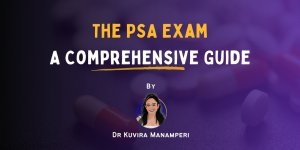
Published January 30, 2024 | Updated June 11, 2024
By Dr. Maliha Darmini
This is Dr. Maliha Darmini, an IMG in the UK. Trying to balance my medical expertise with the craft of storytelling.
The ST1 application for Ophthalmology is known for its competitiveness and demands more than just academic knowledge. OST has the 5th highest competition ratio of all CT/ST1 specialities at 9.91 in 2023.
Aspiring ophthalmologists face a tough selection process, and to navigate it successfully requires a thoughtful strategy.
In this article, we will explore the Ophthalmology ST1 application, offering practical advice and insight to help candidates not only survive but excel in their quest to join this fascinating medical field.
We’ll walk you through:


Sean and Binita are both Ophthalmology trainees at NHS HEE East of England, having started ST1 together in 2019. They both have an interest in medical education with Binita now taking up the role of regional simulation lead, as well as clinical lead of Women in Vision UK.
Sean has taken a lead on the digital learning front both on a regional level as a HEE Blended Learning Fellow, and on a national scale as the Professional Development Lead on the Digital Learning Subcommittee of the Royal College of Ophthalmologists.
They’ve combined their passion for medical education and helped many applicants since setting up their bespoke course EyePrep in 2019 with other fantastic colleagues in the region. If you want to gain an edge when it comes to your OST application and interview, book a course with EyePrep.
Key Documents
OST Recruitment Timeline
Check the schedule for crucial dates during the selection process on the recruitment timetable. The timetable is also accessible in the resources section on the National Ophthalmology website.
| Vacancies published | Wednesday 25th October 2023 by 5pm |
| Applications open | Thursday 26th October 2023 at 10am |
| Applications close | Thursday 23rd November 2023 at 4pm |
| Invitation to MSRA | By Thursday 14th December 2023 |
| MSRA Exam | Thursday 4th – Tuesday 16th January 2024 |
| Evidence Document Upload | Wednesday 7th – Tuesday 13th February 2024 |
| Evidence Folder Feedback | Wednesday 21st – Friday 23rd February 2024* |
| Invitation to interview | Wednesday 6th March 2024 |
| Interviews | Friday 15th March 2024 |
| Interview Feedback | 22nd March 2024 |
| Initial Offers out | By Tuesday 26th March 2024 |
| Post start date | Wednesday 7th August 2024 |
The Severn deanery site gives 2 dates for the evidence folder feedback – 21st Feb or 23rd Feb – depending on which page you look at. We have confirmed with Severn PGME that it will be sometime between these dates:
“Due to the timescale that we are running to the earliest will be the 21st and the latest will be the 23rd for the release of feedback.“
Severn PGME
Ophthalmology ST1 Application Process
The national selection process for Ophthalmology at Level One (ST1) is entirely coordinated by NHS England (South West).
Candidates begin their journey from searching for suitable training posts and locations to the application process through the Oriel Recruitment System. Find the latest updates on their official site.
Sean & Binita’s Tips – Approach to the Applications
While the competition is fierce, it is important to also remember this is a wonderful speciality with a run-through programme which means no second round of competition at the ST3 stage. Do not be disheartened if you do not achieve a post on your first attempt, many now-successful Ophthalmologists were the same and achieved success in second or later attempts.
The key to a successful application is preparation (which you’re already doing by reading this guide!) and having a plan to pick up as many points as possible in the lead-up to the portfolio deadline.
How Competitive is Ophthalmology ST1 Application?
For the August 2023 start date a substantial 971 applications were submitted for a limited number of 98 available positions, resulting in a competition ratio of 9.91.
This figure underscores the rigorous competition, translating to nearly 10 applicants battling for each available position.

Not all of these will be “competitive candidates”. The influx of IMGs joining round 1 applications in the past couple of years may mean there are some applicants who haven’t had the chance to craft a perfect evidence folder due to cultural differences in healthcare systems.
Nevertheless, the competition ratio has always been high and appears to be getting higher.

Eligibility Criteria
Meeting the eligibility criteria is the first crucial step. Applicants must comply with the “Essential” requirements in the Person Specification. These include:
A notable change in 2024 is the extension of the maximum duration in Ophthalmology to 30 months (previously 18 months) by the time of appointment. The deanery is also no longer recruiting for ST3 Ophthalmology in 2024.
Detailed information can be found on the Medical Specialty Website.
The Selection Process
The selection process comprises three stages, each carrying its weight in determining your success:
1. Multi-Specialty Recruitment Assessment (MSRA)
Like other Postgraduate medical training such as GPST, Clinical Radiology ST1, ACCS Emergency Medicine, Anaesthetics, etc., MSRA is a pivotal examination for Ophthalmology. It is a multiple-choice examination comprising an SJT-type component and general medical questions.
Only the top 300 top scorers will be eligible for the next stage of application. So, a good score in the MSRA is essential for advancing to the next stages.
We don’t have an MSRA guide out *yet*, but take a look at Medibuddy’s MSRA guide for some advice.
2. Evidence Folder
Only the top 300 applicants progress to this stage. Submission of an evidence folder helps to further rank candidates, showcasing achievements in specified domains like qualifications, awards, and commitment to ophthalmology.
Clear organisation and adherence to the mark scheme are equally important. We’ll go through this later in the article.
Only candidates who score 40% or above will move on to the ophthalmology interview.
3. Online Interview/Assessment
Theoretically, every one of the 300 top MSRA scorers who made it to the second stage could make it to interview. However, only those who score 40% or above in their evidence folder is eligible.
So without knowing exactly how many make it to interview, we know less than 300 candidates will make it to this stage.
Going off these numbers, if you’ve made it to this stage you’ve got a 1 in 3 chance of getting a training number (and potentially closer to 1 in 2).
We talk more on this in our interview guide.
Application Scoring
Post-MSRA, your performance in the evidence folder and online interview are amalgamated to determine your overall score, determining your ranking among other candidates.
The maximum score for each section is:
At the end of the application process, each candidate that has met the shortlisting threshold will be ranked based on this mark out of 100. Posts are allocated based on rank and preferences, with offers coming through on 26th March 2024 at the latest.
Don’t Forget
Applicants need to prove they meet the requirements during the application process, assessed in both longlisting and after receiving interview offers. Just reaching the interview stage doesn’t mean all requirements are met. The criteria include immigration status, core skills, and following the specified training duration.
Applicants might be removed even after interviews if their evidence for eligibility is not enough.
Nevertheless, At this point, If you’ve been shortlisted for an interview invitation, it’s time to concentrate on getting ready for the interview.
Ophthalmology Evidence Folder Scoring
As the evidence folder holds a significant weight of up to 50 points out of a total of 100 for all application elements, so preparation is essential.
Candidates must upload documentation to an online portal, following specific domain headings and content lists precisely. When arranging your evidence folder, adhere to the guidelines provided on the Severn website.
It’s equally important to remember that interviewers will be reviewing numerous anonymous evidence folders, emphasising the importance of a well-organised presentation.
| Domain | Maximum Points |
|---|---|
| Previous Posts | 0 (for eligibility only) |
| Qualifications | 5 |
| Prizes and Awards | 5 |
| Commitment to Ophthalmology | 12 |
| Multi-Source Feedback | 3 |
| Publications | 6 |
| Quality Improvement & Audit | 5 |
| Presentations | 6 |
| Teaching & Education | 5 |
| Overall Layout & Quality | 3 |
| Total | 50 |
Evidence Folder Domains
There are 10 domains within the evidence folder, though only 9 of these carry points. The points will help you get invited to interview – if you score 20+ you will be eligible for interview.
These points are also very valuable when it comes to final selection, making up 50% of the final grade.

Below is a breakdown of the different domains within the evidence folder and the specific areas for which you can earn points. There is more detailed guidance on the Severn Deanery website.
Domain 1: List of Previous Posts
This segment will not contribute to the scoring, but you still need to furnish a comprehensive catalogue of your past contributions. Failure to do so might affect your eligibility.
Domain 2: Qualifications
A cumulative maximum of 5 points is available for the following:
- 1 point – per qualification – MSc, BSc, PG Cert
- 3 points –For a standalone program leading to either an MD or MPhil degree.
- 4 points –For a successfully concluded PhD or DPhil, typically involving a three-year duration of full-time research.
Scoring does not apply to MRCP, MRCS, or Diploma in Child Health, nor does it count for intercalated degrees or other degrees you obtained as part of your primary medical degree (including MD if you were awarded this during med school).
An MD or MPhil degree must have been awarded after 2 years of full-time additional study and research. For PhD or DPhil, this is usually at least 3 years duration.
However, passing FRCOphth Part 1 holds three points in the “commitment to speciality” section later on. Hence, focusing on FRCOphth Part 1 in Foundation Year 1 or 2 would be a wiser attempt if you are determined to maximise your points here.
You need certificates or letters of proof to claim these points.
Domain 3: Prizes & Awards
A cumulative maximum of 5 points is available for the following:
- 3 points – For earning the Crombie Medal for scoring as the #1 candidate on your sitting of the FRCOphth part 1 exam.
- 2 points for each:
- Securing a first, honours, or distinction in your final undergraduate degree
- Achieving a Duke-Elder Prize grade in the top 10% of entrants
- 1 point for being in the top 20% of entrants in other prize exams
- 0.5 points for each:
- Outstanding presentation or poster award at a national or international meeting
- Achieving a Duke-Elder Prize grade in the top 60% of entrants
- For a successful research grant application, resulting in a lead author peer-reviewed research publication
- Each prize, distinction, or merit related to your medical/dental degree or foundation programme (max 2 points)
For degrees preceding or following a primary medical degree, you should be able to demonstrate that less than 15% of the year is awarded the grade you were awarded.
For prizes related to your medical degree or foundation programme, you should be able to demonstrate that this is given to no more than the top 20% of entrants.
If you claim 0.5 points for an oral or poster presentation, you can also use this presentation in the “presentations” section.
Domain 4: Ophthalmology speciality links and commitment to date as a career
A cumulative maximum of 12 points is available in this section:
- 3 points – FRCOphth Part 1
- 3 points (max) – Meetings attended
- (1 point each) – National / International ophthalmology educational meetings
- (0.5 points each) – Regional ophthalmology meetings including RSM ophthalmology Section (2 points max)
- 2 points – Refraction Certificate (or optometry exemption)
- 2 points (max) – First-author publications*
- (0.5 points each) Non-peer-reviewed publications & case reports in ophthalmology
- (1 point each) Other peer-reviewed or Pubmed cited research publications in ophthalmology
- These must not be included in other sections.
- 2 points max – Ophthalmic elective or separate undergraduate project (1 point each)⁺
- 1 point – Ophthalmology taster week
- 1 point – Attending ophthalmology clinics and theatre sessions (not including taster week)°
- 1 point – EyeSi assessments (minimum 4 hours).
- 1 point – Evidence of ophthalmology simulation training (outside of EyeSi assessments)
*For non-peer-reviewed publications, you must indicate the impact these have had.
⁺If electives were cancelled due to COVID, you can still claim this if you can prove that it was planned.
°Clinic and theatre sessions must be spaced out over at least 3 months and include a minimum of 10 sessions with dates & supervisor-signed evidence.
There is also a discretionary 2 points available for evidence not included in the list above (not including taking Duke-Elder Prize or completing a surgical logbook or WBAs).
The key to maximising points in this section is to plan well in advance to get the full 12 marks. Some such as; the taster week, EyeSi assessments, or meetings attended, are easier than others.
Domain 5: Multi-Source Feedback (MSF)
Maximum 3 points available here:
- 3 points – Satisfactory score with multiple superlative positive comments*
- 2 points – Satisfactory score with appropriate good comments
- 1 point – Minor negative comments or non-satisfactory scores
- 0 points – Significant negative comments
*Severn Deanery gives the example of a “superlative positive comment” as something like “best trainee I have ever worked with”.
Ensure that your MSF corresponds to the 18 months leading up to the interview if you’ve been in a clinical post during this time. Otherwise, include the MSF from your most recent clinical post. Severn deanery gives some Multi-Source Feedback Guidance here.
Domain 6: Publications
This domain has a cumulative maximum of 6 points available:
- 3 points each – 1st or joint 1st author*
- 1 point each – 2nd to 4th author (unless >8 authors in total for article when 1st author only counted)
*You will only get 1 point if there are 3 or more “1st authors”, and will get no points if there are 7 or more “1st authors.”
Letters to a journal and case reports do not count in this section. However, you can use them in the commitment to speciality section if they are ophthalmology related.
Choose whether to include your work in commitment to speciality, presentations or publications, not more than one.
Use the provided pro forma (warning – this will download a Word doc) to list peer-reviewed articles, and attach a photocopy of each paper’s first page.
All achievements should be completed at the time of application, and peer-reviewed evidence must be cited in PubMed. In-press publications can count here, but you must provide proof of final acceptance.
Domain 7: Quality improvement / Audit projects
There are a maximum of 5 points available here, and this is not cumulative:
- 5 points – Published audit or implementation of QI guidelines supra-regionally.*
- 4 points – As per 3 points, plus personal involvement in implementing QI strategy, completing the audit loop/QI cycle, and implementing change.
- 3 points – Initiation, design, and writing up QIP/audit with a specific format.
- 2 points – Initiation and design of QIP/audit with some evidence of specific format.
- 1 point – Participation without documented roles or specific format.
- 0 points – No evidence of QI or Audit work.
*For 5 points, you should not include this publication in the publications section.
Note: Maximum score is 1 point if you are not clearly leading the project.
Provide your top Quality Improvement (QI) project or audit conducted within the last 3 years, along with a summary of your role. You can rack up 4-5 points fairly easily here if you keep a limited scope on a topic that you can quickly gather data and make changes.
The audit should include standards, outcomes, and recommendations. A signed cover letter from the supervising consultant is required for confirmation and proof of presentation.

Domain 8: Presentations:
There are a maximum of 6 points available cumulatively. Pay close attention to the rules below, as this can get tricky:
- 3 Points – International presentations including Association for Research in Vision and Ophthalmology, American Academy of Ophthalmology, or equivalent international conferences. These must be intended for an international audience.
- 2 Points – National presentations including RCOphth Congress, British Oculoplastic Surgery Society, or equivalent non-ophthalmology national conferences in the UK. National ophthalmology presentations in other countries also count here if intended for a national audience.⁺
- 1 Point – Regional presentations including regional ophthalmology or other speciality societies in the UK or equivalent ophthalmology gatherings in other countries.*
*Local hospital or university meetings do not score here
⁺Meetings specific to England Wales, Scotland, or Northern Ireland only count as regional. National must be meetings aimed at a society covering the whole of the UK.
You can only count a paper in one of these categories, even if you have presented it in multiple places. To earn cumulative points, these must be for different papers. Each presentation must be original work and not didactic lectures.
Presentations not yet delivered but with proof of acceptance will be awarded points.
Poster presentations and 2nd or lower author presentations only count for half of the points in each category.
Share a list of presentations along with abstracts or posters, and mention if it’s an oral or a poster presentation. Prove it by including an abstract book or a letter from your supervisor.
Domain 9: Education and Teaching
A maximum of 5 cumulative points are allocated as follows:
- 3 points – writing a postgraduate-level academic book (excluding e-books or self-published works), with evidence of the publisher and the book’s impact.
- 2 points – for obtaining a higher teaching qualification, such as a PG Diploma or PG Certificate in Medical Education.
- 2 points – for writing a chapter in a postgraduate-level academic book (excluding e-books or self-published works), with evidence of the publisher and the book’s impact.
- 1 point – for contributing to 3+ teaching sessions spanning at least 3 months, accompanied by formal feedback. This can include if you’re taking part in a teaching fellow year.
- 0.5 points each for assisting with educational courses (2+ sessions), designing e-learning tools, writing e-books, completing a “teach the teacher” course, and/or holding a formal role in examining undergraduates.
Submit proof in the form of photocopies of a chapter index, an attendance certificate, or a signed letter from a supervisory consultant or educator.
Include specific evidence illustrating the impact of e-learning projects or other teaching accomplishments such as download numbers or other accessibility metrics.
Domain 10: Overall Portfolio Layout and Quality
A maximum of 3 points are available here. No guidance is given here for candidates, other than the fact that this will be marked on your portfolios:
- Layout
- Organisation
- Quality
This could be an easy 3 points if you put time into making your portfolio easy to read and quick to find the correct details, as laid out in this mark scheme.
Sean & Binita’s Tips – Portfolio
We have helped many applicants through the process over the years, and one of the most useful things they’ve found is sitting down with someone and going through each point of the portfolio and making an action plan on how to achieve them.
Scoring maximum marks on certain sections such as “commitment to speciality” is very doable and you must try and achieve this to obtain the “easy points”. Other sections such as additional qualifications are more difficult as not everyone can obtain a PhD before applying!
Therefore, target your areas of weakness, and remember things always take longer than you plan to complete. So let your supervisors know your goals, and timelines, and make sure you start and complete any research projects and/or audits in good time, not just in the few months before the submission deadline.
Lastly, remember to keep a record of everything, and once you complete a project or a speciality commitment section, get that certificate signed by your supervisor to avoid the last-minute rush and stress of chasing others for paperwork.
Summary
Creating a well-prepared evidence folder or portfolio is beneficial for any specialty application.
It’s advisable to begin early and stay organised, as the process of filing and gathering evidence tends to require more time than anticipated.
Achieving a high-quality and well-organised folder not only assists assessors but also provides an opportunity to earn three additional points!
As soon as you’ve finished reading this, start putting together a log:
Get going on this now to save yourself a whole lot of stress when it comes time to submit and upload your evidence folder.
Good luck!












